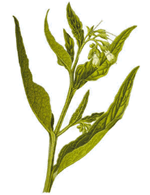
Comfrey
Introduction
This fact sheet provides basic information about Comfrey. Comfrey grows in moist ground in valley and meadows in regions from Newfoundland south to Georgia and west to Louisiana. Comfrey can also be found growing in similar climates and geographies in Europe.
Common Names
Comfrey, Russian Comfrey, Knitbone, Bruisewort, Blackwort, Slippery Root
Latin Names
Symphytum officinale
What It Is Used For
Comfrey is most commonly used in connection with the following conditions:
- Bruises
- Sprains and Strains
- Dislocations
- Wounds
How It Is Used
The therapeutic use of comfrey is limited because of its potential toxicity. Comfrey has antifungal and anticancer activity, and has been used topically for treating musculoskeletal and inflammatory disorders. Because of limited evidence and toxicity, comfrey is not recommended for oral use.
What the Science Says
- The internal or extensive topical use of comfrey cannot be recommended because of numerous reports of liver toxicity.
- A S. officinale extract has been reported to enhance uterine tone. The action of the extract was reported to be stronger than shepherd's purse and St. John's wort, but weaker than that exhibited by German chamomile, calendula, and plantain.
- The FDA released an advisory in July 2001 recommending that comfrey products be removed from the market following several cases of hepatic veno-occlusive disease. Also in 2001, the Federal Trade Commission brought enforcement action against a company marketing comfrey-containing products. The parties agreed to a preliminary injunction that prohibited the company from marketing any comfrey-containing products intended for internal use or use on open wounds, further requiring a warning on comfrey products intended for external use.
Side Effects and Cautions
- Comfrey is not recommended for internal or even limited topical use today because of the content of hepatotoxic PAs. Older preparations may still be on the market in Europe and Asia. For informational purposes, typical historical daily doses of the leaf ranged from 5 to 30 g.
- Because of the content of hepatotoxic PAs, comfrey is not recommended for internal use. Patients with hypersensitivity or allergic reactions to the plant should avoid external use. It is contraindicated during pregnancy and lactation and in patients with liver or kidney disease.
Sources







